ECO mode SKODA ROOMSTER 2006 1.G Owner's Manual
[x] Cancel search | Manufacturer: SKODA, Model Year: 2006, Model line: ROOMSTER, Model: SKODA ROOMSTER 2006 1.GPages: 274, PDF Size: 48.64 MB
Page 2 of 274
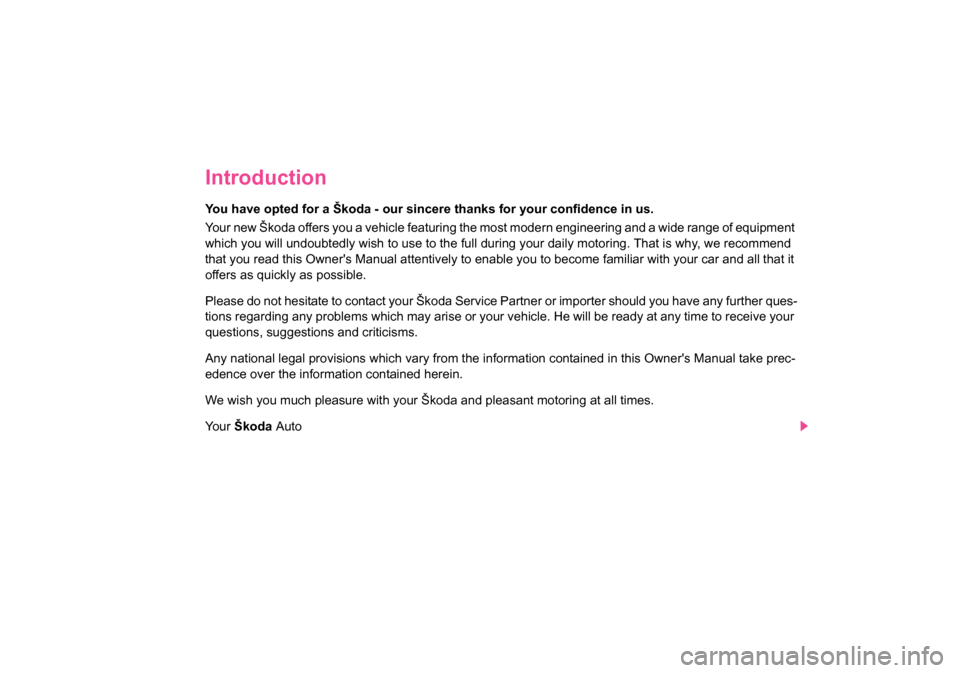
Introduction
You have opted for a Škoda - our sincere thanks for your confidence in us.
Your new Škoda offers you a vehicle featuring the most modern engineering and a wide range of equipment
which you will undoubtedly wish to use to the full during your daily motoring. That is why, we recommend
that you read this Owner's Manual attentively to enable you to become familiar with your car and all that it
offers as quickly as possible.
Please do not hesitate to contact your Škoda Service Partner or importer should you have any further ques-
tions regarding any problems which may arise or your vehicle. He will be ready at any time to receive your
questions, suggestions and criticisms.
Any national legal provisions which vary from the information contained in this Owner's Manual take prec-
edence over the information contained herein.
We wish you much pleasure with your Škoda and pleasant motoring at all times.
Your Škoda Auto
NKO 20 A05.book Page 1 Wednesday, June 21, 2006 1:42 PM
Page 3 of 274
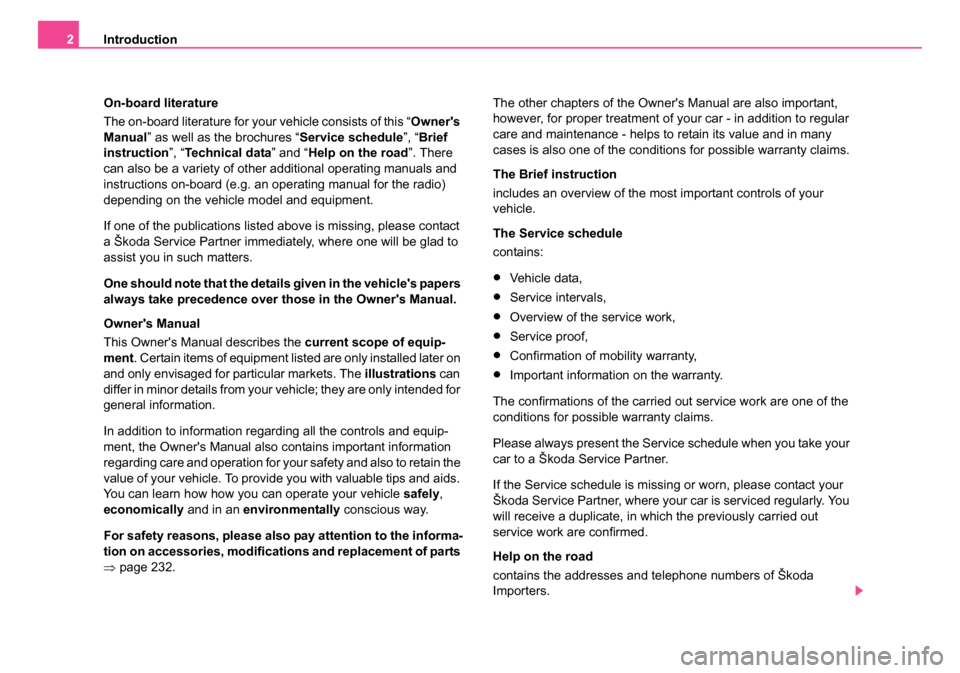
Introduction
2
On-board literature
The on-board literature for your vehicle consists of this “ Owner's
Manual ” as well as the brochures “ Service schedule”, “Brief
instruction ”, “Te c h n i c a l d a t a ” and “Help on the road ”. There
can also be a variety of other additional operating manuals and
instructions on-board (e.g. an operating manual for the radio)
depending on the vehicle model and equipment.
If one of the publications listed above is missing, please contact
a Škoda Service Partner immediately, where one will be glad to
assist you in such matters.
One should note that the details given in the vehicle's papers
always take precedence over th ose in the Owner's Manual.
Owner's Manual
This Owner's Manual describes the current scope of equip-
ment . Certain items of equipment listed are only installed later on
and only envisaged for particular markets. The illustrations can
differ in minor details from your vehicle; they are only intended for
general information.
In addition to information regarding all the controls and equip-
ment, the Owner's Manual also contains important information
regarding care and operation for your safety and also to retain the
value of your vehicle. To provide you with valuable tips and aids.
You can learn how how you can operate your vehicle safely,
economically and in an environmentally conscious way.
For safety reasons, please also pay attention to the informa-
tion on accessories, modificati ons and replacement of parts
⇒ page 232. The other chapters of the Owner's Manual are also important,
however, for proper treatment of your car - in addition to regular
care and maintenance - helps to retain its value and in many
cases is also one of the conditions for possible warranty claims.
The Brief instruction
includes an overview of the most important controls of your
vehicle.
The Service schedule
contains:
•Vehicle data,
•Service intervals,
•Overview of the service work,
•Service proof,
•Confirmation of mobility warranty,
•Important information on the warranty.
The confirmations of the carried out service work are one of the
conditions for possible warranty claims.
Please always present the Service schedule when you take your
car to a Škoda Service Partner.
If the Service schedule is missing or worn, please contact your
Škoda Service Partner, where your car is serviced regularly. You
will receive a duplicate, in which the previously carried out
service work are confirmed.
Help on the road
contains the addresses and telephone numbers of Škoda
Importers.
NKO 20 A05.book Page 2 Wednesday, June 21, 2006 1:42 PM
Page 16 of 274
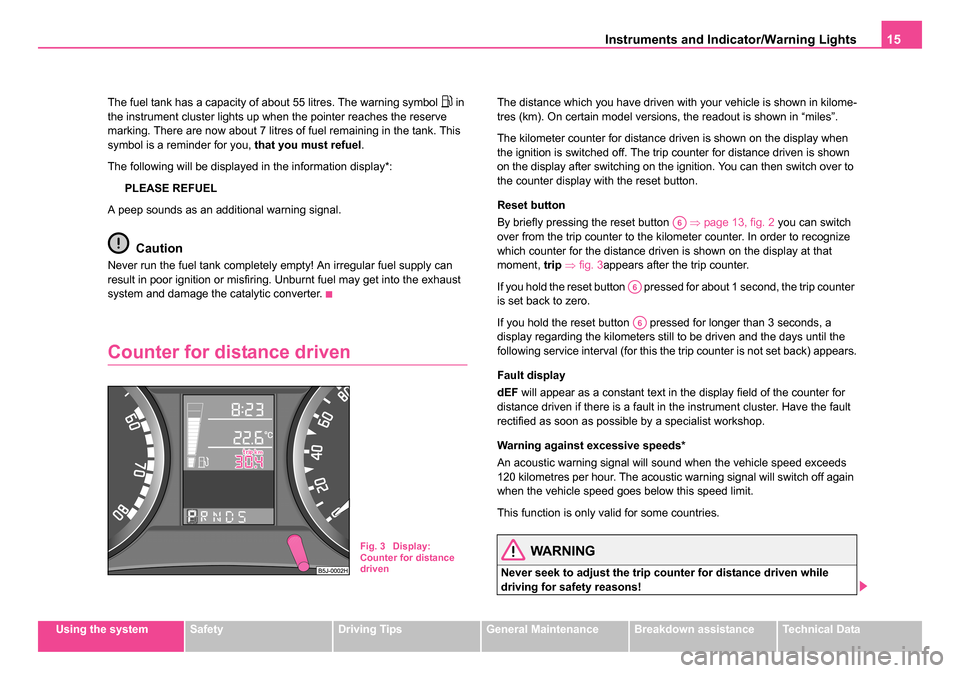
Instruments and Indicator/Warning Lights15
Using the systemSafetyDriving TipsGeneral MaintenanceBreakdown assistanceTechnical Data
The fuel tank has a capacity of about 55 litres. The warning symbol
in
the instrument cluster lights up when the pointer reaches the reserve
marking. There are now about 7 litres of fuel remaining in the tank. This
symbol is a reminder for you, that you must refuel.
The following will be displayed in the information display*: PLEASE REFUEL
A peep sounds as an additional warning signal.
Caution
Never run the fuel tank completely empty! An irregular fuel supply can
result in poor ignition or misfiring. Unburnt fuel may get into the exhaust
system and damage the catalytic converter.
Counter for distance driven
The distance which you have driven with your vehicle is shown in kilome-
tres (km). On certain model versions, the readout is shown in “miles”.
The kilometer counter for distance driven is shown on the display when
the ignition is switched off. The trip counter for distance driven is shown
on the display after switching on the ignition. You can then switch over to
the counter display with the reset button.
Reset button
By briefly pressing the reset button ⇒page 13, fig. 2 you can switch
over from the trip counter to the kilometer counter. In order to recognize
which counter for the distance driven is shown on the display at that
moment, trip ⇒ fig. 3 appears after the trip counter.
If you hold the reset button pressed for about 1 second, the trip counter
is set back to zero.
If you hold the reset button pressed for longer than 3 seconds, a
display regarding the kilometers still to be driven and the days until the
following service interval (for this the trip counter is not set back) appears.
Fault display
dEF will appear as a constant text in the display field of the counter for
distance driven if there is a fault in the instrument cluster. Have the fault
rectified as soon as possible by a specialist workshop.
Warning against excessive speeds*
An acoustic warning signal will sound when the vehicle speed exceeds
120 kilometres per hour. The acoustic warning signal will switch off again
when the vehicle speed goes below this speed limit.
This function is only valid for some countries.
WARNING
Never seek to adjust the trip counter for distance driven while
driving for safety reasons!
Fig. 3 Display:
Counter for distance
driven
A6
A6
A6
NKO 20 A05.book Page 15 Wednesday, June 21, 2006 1:42 PM
Page 39 of 274
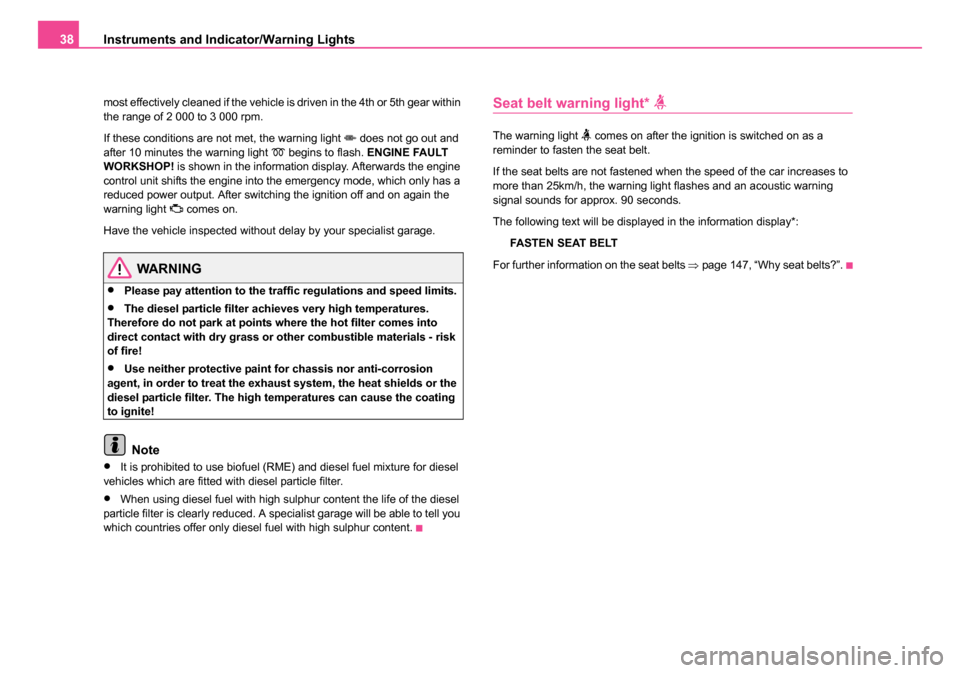
Instruments and Indicator/Warning Lights
38
most effectively cleaned if the vehicle is driven in the 4th or 5th gear within
the range of 2 000 to 3 000 rpm.
If these conditions are not met, the warning light
does not go out and
after 10 minutes the warning light begins to flash. ENGINE FAULT
WORKSHOP! is shown in the information display. Afterwards the engine
control unit shifts the engine into the emergency mode, which only has a
reduced power output. After switching the ignition off and on again the
warning light
comes on.
Have the vehicle inspected without delay by your specialist garage.
WARNING
•Please pay attention to the traffic regulations and speed limits.
•The diesel particle filter achieves very high temperatures.
Therefore do not park at points where the hot filter comes into
direct contact with dry grass or other combustible materials - risk
of fire!
•Use neither protective paint for chassis nor anti-corrosion
agent, in order to treat the exhaust system, the heat shields or the
diesel particle filter. The high temperatures can cause the coating
to ignite!
Note
•It is prohibited to use biofuel (RME) and diesel fuel mixture for diesel
vehicles which are fitted with diesel particle filter.
•When using diesel fuel with high sulphur content the life of the diesel
particle filter is clearly reduced. A specialist garage will be able to tell you
which countries offer only diesel fuel with high sulphur content.
Seat belt warning light*
The warning light comes on after the ignition is switched on as a
reminder to fasten the seat belt.
If the seat belts are not fastened when the speed of the car increases to
more than 25km/h, the warning light flashes and an acoustic warning
signal sounds for approx. 90 seconds.
The following text will be displayed in the information display*:
FASTEN SEAT BELT
For further information on the seat belts ⇒page 147, “Why seat belts?”.
NKO 20 A05.book Page 38 Wednesday, June 21, 2006 1:42 PM
Page 44 of 274
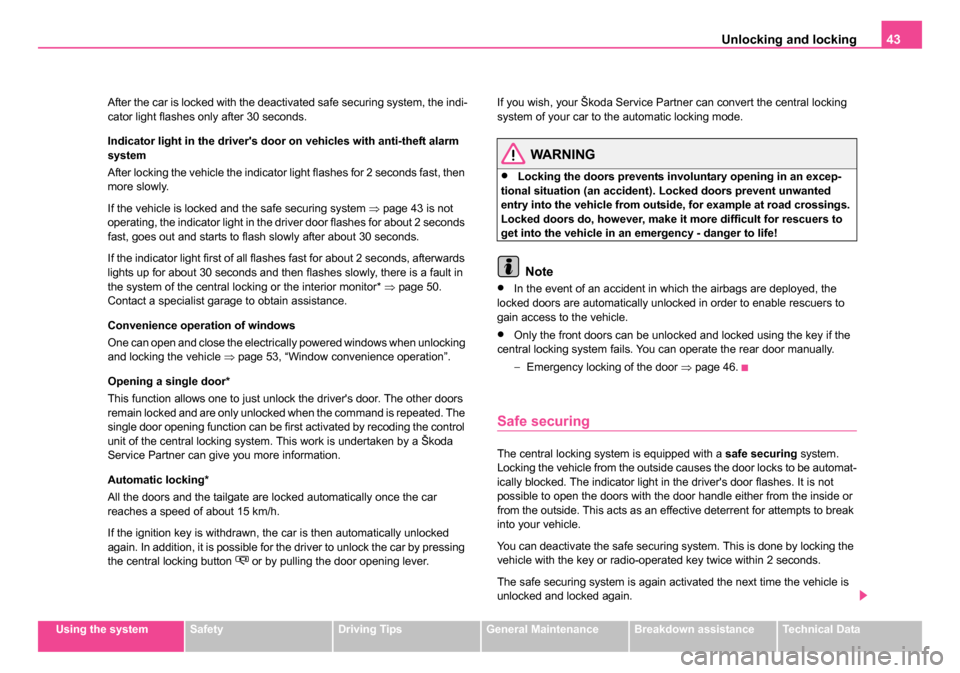
Unlocking and locking43
Using the systemSafetyDriving TipsGeneral MaintenanceBreakdown assistanceTechnical Data
After the car is locked with the deactivated safe securing system, the indi-
cator light flashes only after 30 seconds.
Indicator light in the driver's door on vehicles with anti-theft alarm
system
After locking the vehicle the indicator light flashes for 2 seconds fast, then
more slowly.
If the vehicle is locked and the safe securing system
⇒page 43 is not
operating, the indicator light in the driver door flashes for about 2 seconds
fast, goes out and starts to flash slowly after about 30 seconds.
If the indicator light first of all flashes fast for about 2 seconds, afterwards
lights up for about 30 seconds and then flashes slowly, there is a fault in
the system of the central locking or the interior monitor* ⇒page 50.
Contact a specialist garage to obtain assistance.
Convenience operation of windows
One can open and close the electrically powered windows when unlocking
and locking the vehicle ⇒page 53, “Window convenience operation”.
Opening a single door*
This function allows one to just unlock the driver's door. The other doors
remain locked and are only unlocked when the command is repeated. The
single door opening function can be first activated by recoding the control
unit of the central locking system. This work is undertaken by a Škoda
Service Partner can give you more information.
Automatic locking*
All the doors and the tailgate are locked automatically once the car
reaches a speed of about 15 km/h.
If the ignition key is withdrawn, the car is then automatically unlocked
again. In addition, it is possible for the driver to unlock the car by pressing
the central locking button
or by pulling the door opening lever. If you wish, your Škoda Service Partner can convert the central locking
system of your car to the automatic locking mode.
WARNING
•Locking the doors prevents involuntary opening in an excep-
tional situation (an accident). Locked doors prevent unwanted
entry into the vehicle from outside, for example at road crossings.
Locked doors do, however, make it more difficult for rescuers to
get into the vehicle in an emergency - danger to life!
Note
•In the event of an accident in which the airbags are deployed, the
locked doors are automatically unlocked in order to enable rescuers to
gain access to the vehicle.
•Only the front doors can be unlocked and locked using the key if the
central locking system fails. You can operate the rear door manually.
−Emergency locking of the door ⇒page 46.
Safe securing
The central locking system is equipped with a safe securing system.
Locking the vehicle from the outside causes the door locks to be automat-
ically blocked. The indicator light in the driver's door flashes. It is not
possible to open the doors with the door handle either from the inside or
from the outside. This acts as an effective deterrent for attempts to break
into your vehicle.
You can deactivate the safe securing system. This is done by locking the
vehicle with the key or radio-operated key twice within 2 seconds.
The safe securing system is again activated the next time the vehicle is
unlocked and locked again.
NKO 20 A05.book Page 43 Wednesday, June 21, 2006 1:42 PM
Page 57 of 274
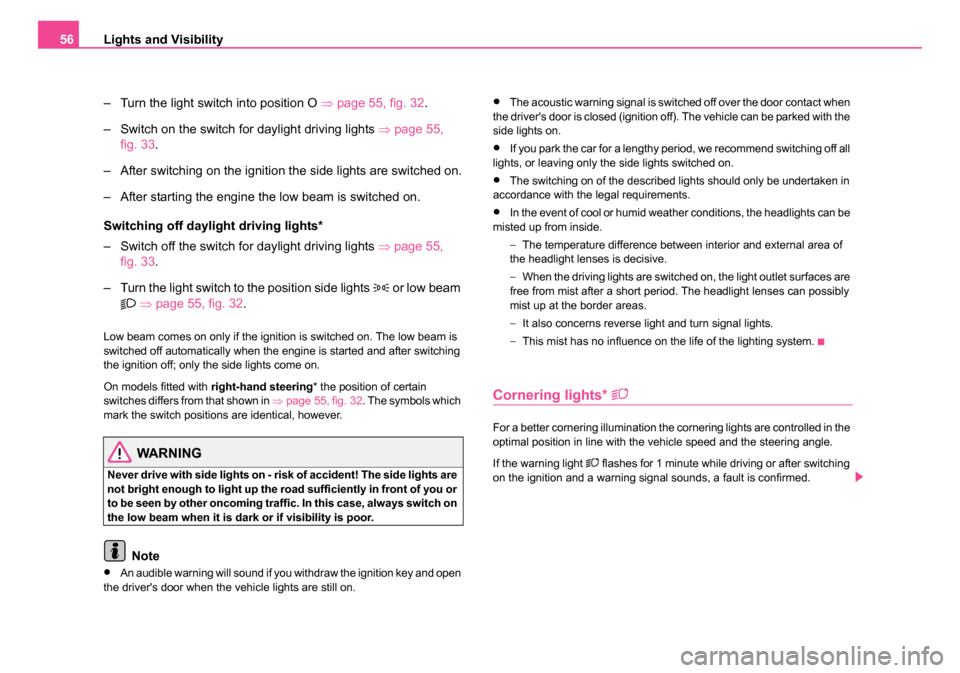
Lights and Visibility
56
– Turn the light switch into position O ⇒page 55, fig. 32 .
– Switch on the switch for daylight driving lights ⇒page 55,
fig. 33 .
– After switching on the ignition the side lights are switched on.
– After starting the engine the low beam is switched on.
Switching off daylight driving lights*
– Switch off the switch for daylight driving lights ⇒page 55,
fig. 33 .
– Turn the light switch to the position side lights
or low beam
⇒ page 55, fig. 32 .
Low beam comes on only if the ignition is switched on. The low beam is
switched off automatically when the engine is started and after switching
the ignition off; only the side lights come on.
On models fitted with right-hand steering* the position of certain
switches differs from that shown in ⇒page 55, fig. 32 . The symbols which
mark the switch positions are identical, however.
WARNING
Never drive with side lights on - risk of accident! The side lights are
not bright enough to light up the road sufficiently in front of you or
to be seen by other oncoming traffic. In this case, always switch on
the low beam when it is dark or if visibility is poor.
Note
•An audible warning will sound if you withdraw the ignition key and open
the driver's door when the vehicle lights are still on.
•The acoustic warning signal is switched off over the door contact when
the driver's door is closed (ignition off). The vehicle can be parked with the
side lights on.
•If you park the car for a lengthy period, we recommend switching off all
lights, or leaving only the side lights switched on.
•The switching on of the described lights should only be undertaken in
accordance with the legal requirements.
•In the event of cool or humid weather conditions, the headlights can be
misted up from inside.
−The temperature difference between interior and external area of
the headlight lenses is decisive.
− When the driving lights are switched on, the light outlet surfaces are
free from mist after a short period. The headlight lenses can possibly
mist up at the border areas.
− It also concerns reverse light and turn signal lights.
− This mist has no influence on the life of the lighting system.
Cornering lights*
For a better cornering illumination the cornering lights are controlled in the
optimal position in line with the vehicle speed and the steering angle.
If the warning light
flashes for 1 minute while driving or after switching
on the ignition and a warning signal sounds, a fault is confirmed.
NKO 20 A05.book Page 56 Wednesday, June 21, 2006 1:42 PM
Page 92 of 274
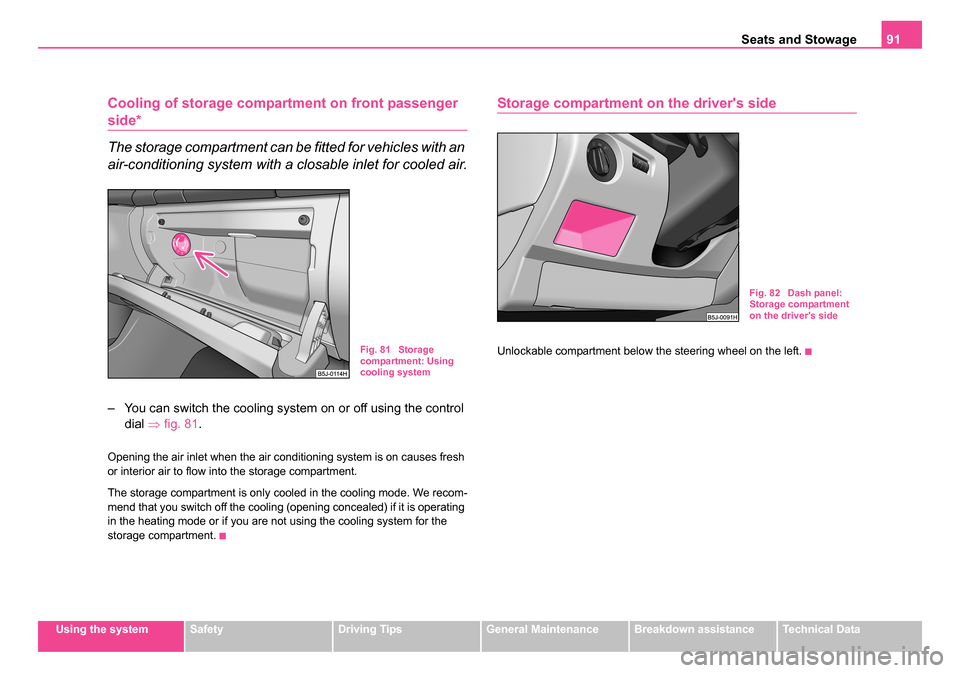
Seats and Stowage91
Using the systemSafetyDriving TipsGeneral MaintenanceBreakdown assistanceTechnical Data
Cooling of storage compar tment on front passenger
side*
The storage compartment can be fitted for vehicles with an
air-conditioning system with a closable inlet for cooled air.
– You can switch the cooling system on or off using the control
dial ⇒fig. 81 .
Opening the air inlet when the air conditioning system is on causes fresh
or interior air to flow into the storage compartment.
The storage compartment is only cooled in the cooling mode. We recom-
mend that you switch off the cooling (opening concealed) if it is operating
in the heating mode or if you are not using the cooling system for the
storage compartment.
Storage compartment on the driver's side
Unlockable compartment below the steering wheel on the left.Fig. 81 Storage
compartment: Using
cooling system
Fig. 82 Dash panel:
Storage compartment
on the driver's side
NKO 20 A05.book Page 91 Wednesday, June 21, 2006 1:42 PM
Page 98 of 274
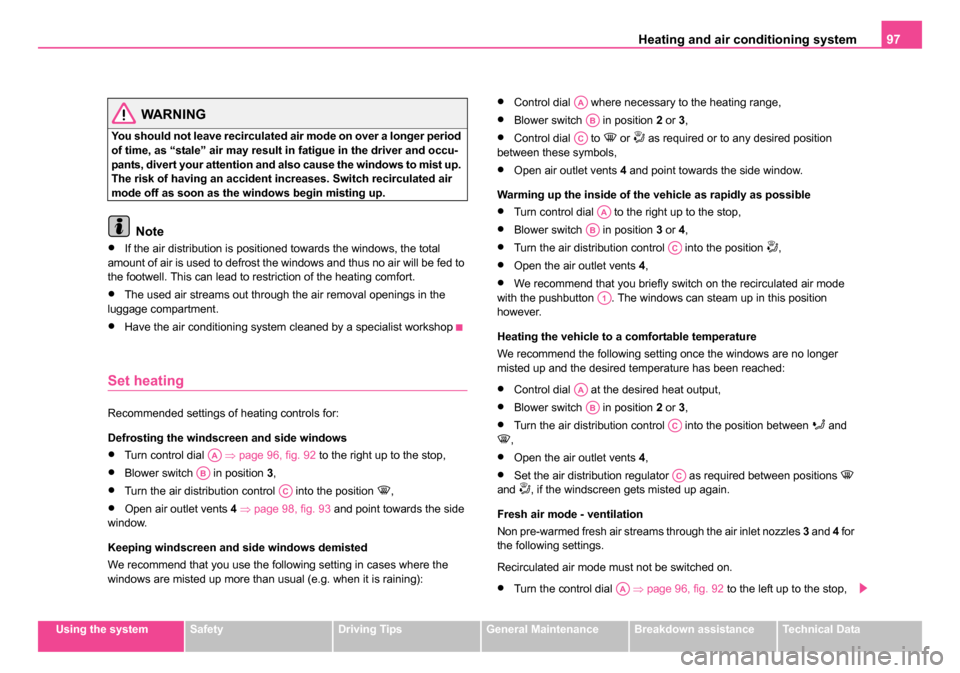
Heating and air conditioning system 97
Using the systemSafetyDriving TipsGeneral MaintenanceBreakdown assistanceTechnical Data
WARNING
You should not leave recirculated air mode on over a longer period
of time, as “stale” air may result in fatigue in the driver and occu-
pants, divert your attention and also cause the windows to mist up.
The risk of having an accident increases. Switch recirculated air
mode off as soon as the windows begin misting up.
Note
•If the air distribution is positioned towards the windows, the total
amount of air is used to defrost the windows and thus no air will be fed to
the footwell. This can lead to restriction of the heating comfort.
•The used air streams out through the air removal openings in the
luggage compartment.
•Have the air conditioning system cleaned by a specialist workshop
Set heating
Recommended settings of heating controls for:
Defrosting the windscreen and side windows
•Turn control dial ⇒page 96, fig. 92 to the right up to the stop,
•Blower switch in position 3,
•Turn the air distribution control into the position ,
•Open air outlet vents 4 ⇒ page 98, fig. 93 and point towards the side
window.
Keeping windscreen and side windows demisted
We recommend that you use the following setting in cases where the
windows are misted up more than usual (e.g. when it is raining):
•Control dial where necessary to the heating range,
•Blower switch in position 2 or 3,
•Control dial to or as required or to any desired position
between these symbols,
•Open air outlet vents 4 and point towards the side window.
Warming up the inside of the vehicle as rapidly as possible
•Turn control dial to the right up to the stop,
•Blower switch in position 3 or 4,
•Turn the air distribution control into the position ,
•Open the air outlet vents 4,
•We recommend that you briefly switch on the recirculated air mode
with the pushbutton . The windows can steam up in this position
however.
Heating the vehicle to a comfortable temperature
We recommend the following setting once the windows are no longer
misted up and the desired temperature has been reached:
•Control dial at the desired heat output,
•Blower switch in position 2 or 3,
•Turn the air distribution control into the position between and ,
•Open the air outlet vents 4,
•Set the air distribution regulator as required between positions
and , if the windscreen gets misted up again.
Fresh air mode - ventilation
Non pre-warmed fresh air streams through the air inlet nozzles 3 and 4 for
the following settings.
Recirculated air mode must not be switched on.
•Turn the control dial ⇒page 96, fig. 92 to the left up to the stop,
AA
AB
AC
AA
AB
AC
AA
AB
AC
A1
AA
AB
AC
AC
AA
NKO 20 A05.book Page 97 Wednesday, June 21, 2006 1:42 PM
Page 101 of 274
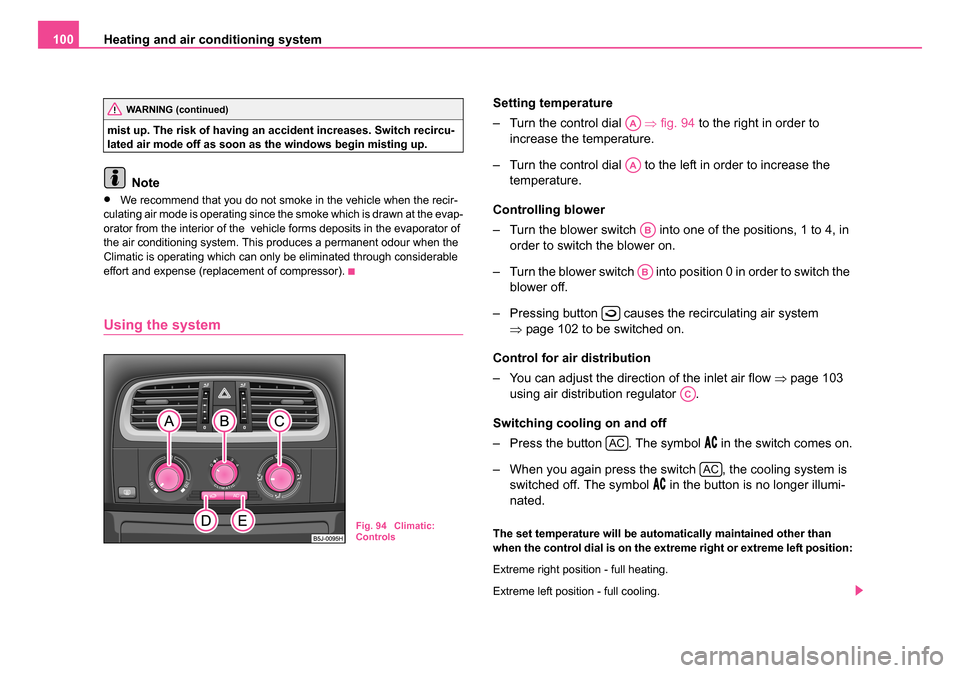
Heating and air conditioning system
100
mist up. The risk of having an accident increases. Switch recircu-
lated air mode off as soon as the windows begin misting up.
Note
•We recommend that you do not smoke in the vehicle when the recir-
culating air mode is operating since the smoke which is drawn at the evap-
orator from the interior of the vehicle forms deposits in the evaporator of
the air conditioning system. This produces a permanent odour when the
Climatic is operating which can only be eliminated through considerable
effort and expense (replacement of compressor).
Using the system
Setting temperature
– Turn the control dial ⇒fig. 94 to the right in order to
increase the temperature.
– Turn the control dial to the left in order to increase the temperature.
Controlling blower
– Turn the blower switch into one of the positions, 1 to 4, in order to switch the blower on.
– Turn the blower switch into position 0 in order to switch the blower off.
– Pressing button causes the recirculating air system ⇒page 102 to be switched on.
Control for air distribution
– You can adjust the direction of the inlet air flow ⇒page 103
using air distribution regulator .
Switching cooling on and off
– Press the button . The symbol
in the switch comes on.
– When you again press the switch , the cooling system is switched off. The symbol
in the button is no longer illumi-
nated.
The set temperature will be automatically maintained other than
when the control dial is on the extreme right or extreme left position:
Extreme right position - full heating.
Extreme left position - full cooling.
WARNING (continued)
Fig. 94 Climatic:
Controls
AA
AA
AB
AB
AC
AC
AC
NKO 20 A05.book Page 100 Wednesday, June 21, 2006 1:42 PM
Page 102 of 274
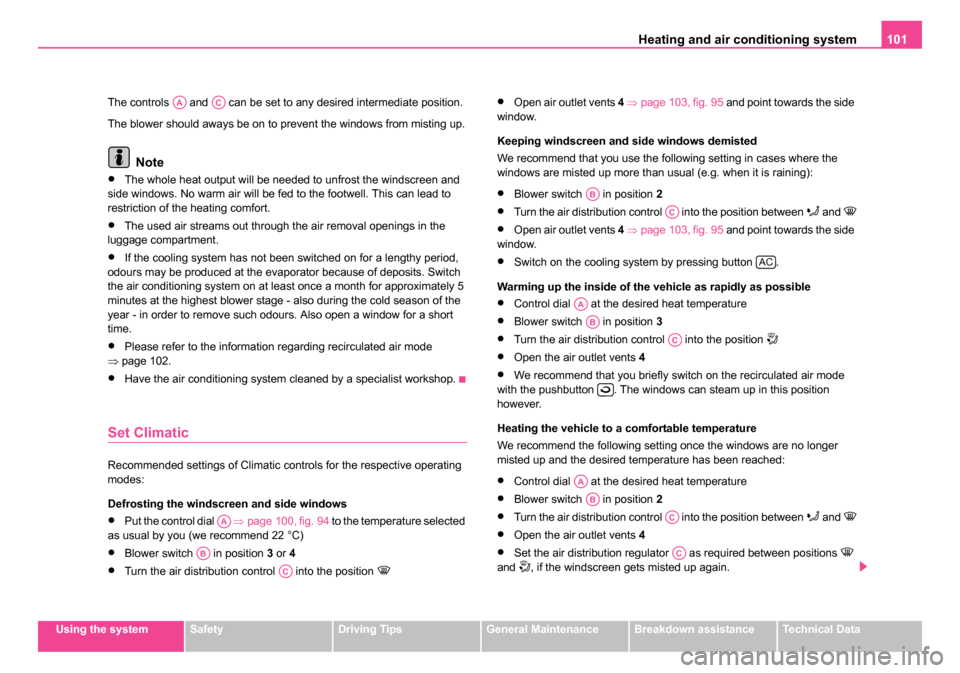
Heating and air conditioning system 101
Using the systemSafetyDriving TipsGeneral MaintenanceBreakdown assistanceTechnical Data
The controls and can be set to any desired intermediate position.
The blower should aways be on to prevent the windows from misting up.
Note
•The whole heat output will be needed to unfrost the windscreen and
side windows. No warm air will be fed to the footwell. This can lead to
restriction of the heating comfort.
•The used air streams out through the air removal openings in the
luggage compartment.
•If the cooling system has not been switched on for a lengthy period,
odours may be produced at the evaporator because of deposits. Switch
the air conditioning system on at least once a month for approximately 5
minutes at the highest blower stage - also during the cold season of the
year - in order to remove such odours. Also open a window for a short
time.
•Please refer to the information regarding recirculated air mode
⇒ page 102.
•Have the air conditioning system cleaned by a specialist workshop.
Set Climatic
Recommended settings of Climatic controls for the respective operating
modes:
Defrosting the windscreen and side windows
•Put the control dial ⇒page 100, fig. 94 to the temperature selected
as usual by you (we recommend 22 °C)
•Blower switch in position 3 or 4
•Turn the air distribution control into the position
•Open air outlet vents 4 ⇒ page 103, fig. 95 and point towards the side
window.
Keeping windscreen and side windows demisted
We recommend that you use the following setting in cases where the
windows are misted up more than usual (e.g. when it is raining):
•Blower switch in position 2
•Turn the air distribution control into the position between and
•Open air outlet vents 4 ⇒ page 103, fig. 95 and point towards the side
window.
•Switch on the cooling system by pressing button .
Warming up the inside of the vehicle as rapidly as possible
•Control dial at the desired heat temperature
•Blower switch in position 3
•Turn the air distribution control into the position
•Open the air outlet vents 4
•We recommend that you briefly switch on the recirculated air mode
with the pushbutton . The windows can steam up in this position
however.
Heating the vehicle to a comfortable temperature
We recommend the following setting once the windows are no longer
misted up and the desired temperature has been reached:
•Control dial at the desired heat temperature
•Blower switch in position 2
•Turn the air distribution control into the position between and
•Open the air outlet vents 4
•Set the air distribution regulator as required between positions
and , if the windscreen gets misted up again.
AAAC
AA
AB
AC
AB
AC
AC
AA
AB
AC
AA
AB
AC
AC
NKO 20 A05.book Page 101 Wednesday, June 21, 2006 1:42 PM